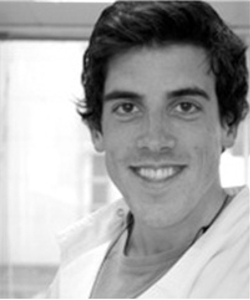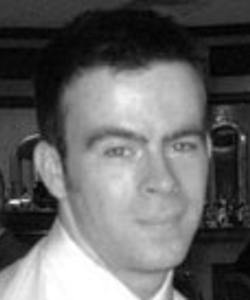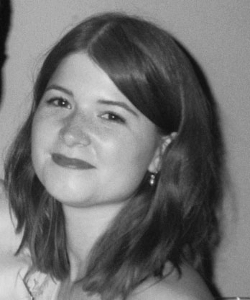School of Biochemistry prize for the best talk by a third year Biochemistry postgraduate student
The School of Biochemistry celebrates the research of our postgraduate research students in a series of talks each year and awards a prize to the best talk given by one of our third year postgraduates. Here are our award winners over the years.

Caitriona Topping
Joe Hawksworth
Kerrie McNally
2017: Discovery Of ‘Retriever, An Ancient Endosomal Sorting Complex
Central to the biogenesis and homeostasis of all eukaryotic organelles is the controlled delivery and removal of integral membrane proteins. A major nexus for determining the correct and efficient transport of integral membrane proteins is the endosomal network. Here the fate of integral membrane proteins and their associated proteins and lipids (together termed ‘cargos’) is determined. Either cargo are trafficked to the lysosome for degradation or recycled to organelles that include the plasma membrane, the trans-Golgi network, lysosome-related organelles, and the autophagosome. Consistent with the fundamental role of the endosomal network in establishing and maintaining organelle function, perturbations in the network are increasingly being associated with human disease.

Chris Wood
2016: The computational design of parameterisable protein folds
Chris works in the field of de novo protein design, which combines principles and methods from biochemistry, chemistry, computing, mathematics and physics. Its aims are twofold: firstly, to test our understanding of how a protein’s amino-acid sequence defines its functional 3-dimensional structure; and secondly to generate entirely novel protein structures and functions with potential applications in synthetic biology and biotechnology.
Chris started his PhD by building on previous research in the Woolfson group, notably finishing a piece of software called CCBuilder. This was developed to model a broad class of protein known as the α-helical coiled coil. He then used the software to design a rare subclass of coiled coil known as the α-helical barrel, predicting 3-dimensional structures for several designs that matched well with the subsequently determined experimental structures. Chris then generalised this approach to any parameterisable protein fold and started to develop a new protein-design package called ISAMBARD (Intelligent System for Analysis, Model Building and Rational Design). In the latter stages of his PhD, Chris applied this software to design different classes of small proteins, particularly targeting fully de novo forms, which are predicted but not observed in nature.

Mark Richards
2015: Cytoskeletal regulation of endothelial polarization and apical specification
Blood vessel formation requires careful communication between cells to coordinate shape and movement. Initially, cells form a chord-like structure that then has to rearrange to form a central space, or lumen, for the blood to flow through. The lumen must be continuous between cells in the vessel, but never with the sides of the forming tube so that blood does not leak into surrounding tissue. The mechanisms underpinning the process of lumen formation are poorly understood, but are critical for the formation of functional, healthy vasculature.
In his PhD studies, Mark showed that the cytoskeletal regulator FMNL3 plays a critical role in regulating the early stages of lumen formation. He found that FMNL3 reorganizes the endothelial cell actin cytoskeleton to direct intracellular trafficking to what will become the luminal surface. Specifically, Mark showed that trafficking of podocalyxin to the early luminal surface depends on this process. This trafficking is important for establishing the early apical identity of the pre-luminal surface, with delivery of podocalyxin being important for the opening of the luminal space prior to the establishment of blood flow. His work was published in the journal Current Biology (Richards, Hetheridge and Mellor; Curr. Biol 27, 2325-2331).
Mark's work gives important insight into blood vessel formation, but also informs studies on other polarized structures in biology that require cells to organize around a central space. He is currently continuing his studies of blood vessel formation at the University of Stockholm, through award of an EMBO Fellowship.

Nicole Antonio
2014: Modulation of the inflammatory response towards cancer in zebrafish
Nicole's PhD project involved using translucent larval and adult zebrafish to model cancer biopsies and surgery. Her most striking observation was that after making laser wounds close to clones of fluorescently-tagged pre-neoplastic melanoma cells she saw, firstly, rapid recruitment of leukocytes to the wound, but subsequently these immune cells were soon distracted by the melanoma cells in the vicinity of the wound; this increased interaction between immune cells and cancer cells leads to enhanced growth of the cancer clones and clearly has implications for cancer surgery.
Nicole has been collaborating with Danish plastic surgeons to draw parallels between what she sees in zebrafish and what happens in real patients.

Tom MacVicar
2013: Mitochondrial dynamics and mitophagy: essential protection against misbehaving mitochondria
Dysfunctional mitochondria pose a grave threat to high-energy demanding tissues and are associated with an array of human diseases. A damaged mitochondrion must first be exiled from the network by mitochondrial fission and next be selectively degraded by a process termed mitophagy. However, we now demonstrate how cells dependent on oxidative phosphorylation can avoid mitophagy via intricate control of mitochondrial dynamics. In order to maintain the energy supply, respiring cells resist mitophagy by preserving an interconnected mitochondrial network via inhibition of Drp1 and impaired OMA1-dependent OPA1 cleavage. In addition, whilst the mechanistic regulation of mitophagy remains poorly understood, our recent data suggest that ER-mitochondrial Ca2+ signaling plays a crucial role in the selective eradication of damaged mitochondria.
Further research will be required to identify whether these two regulatory arms are linked and will strengthen the therapeutic potential for positively modulating mitochondrial homeostasis in order to promote cell protection.

Ian McGough
2012: A SNX3-dependent retromer pathway mediates retrograde transport of the Wnt sorting receptor Wntless and is required for Wnt secretion
Wnt proteins are lipid-modified glycoproteins that play a central role in development, adult tissue homeostasis and disease. Secretion of Wnt proteins is mediated by the Wnt-binding protein Wntless (Wls), which transports Wnt from the Golgi network to the cell surface for release. It has recently been shown that recycling of Wls through a retromer-dependent endosome-to-Golgi trafficking pathway is required for efficient Wnt secretion, but the mechanism of this retrograde transport pathway is poorly understood.
In collaboration with the laboratory of Dr Rik Korswagen (Hubrecht Institute, The Netherlands) we have shown that Wls recycling is mediated through a retromer pathway that is independent of the retromer sorting nexins SNX1-SNX2 and SNX5-SNX6. We have found that the unrelated sorting nexin, SNX3, has an evolutionarily conserved function in Wls recycling and Wnt secretion and show that SNX3 interacts directly with the cargo-selective subcomplex of the retromer to sort Wls into a morphologically distinct retrieval pathway. These results demonstrate that SNX3 is part of an alternative retromer pathway that functionally separates the retrograde transport of Wls from other retromer cargo and is a crucial mediator of Wnt morphogenic gradient formation.

Sarah Whitehouse
2011: Bacterial protein translocation is mediated by the SecYEG channel and the SecA ATPase
The mechanism by which protein translocation is coupled to ATP hydrolysis and subsequent conformational changes is not fully understood. A recent structure of SecA bound to SecYEG indicated that a two-helix finger domain within SecA is suitably positioned to interact with polypeptide substrates and push them through SecYEG. To test this hypothesis we have cross-linked the tip of the two-helix finger to residues at the periphery of the SecYEG channel, or deep within it. We find that immobilisation at the channel edge permits substrate translocation, but fixation deeper within it blocks transport because the two-helix finger is arrested such that it obstructs the pathway of the translocating polypeptide. Through this approach we show that the SecA two-helix finger remains static during substrate translocation.

Jade Cheng
2010: Roles of the Golgi stacking protein GRASP65 in apoptosis and mitosis
GRASP65 is an important structural and regulatory component of the Golgi apparatus. It links adjacent Golgi stacks and facilitates membrane traffic through the Golgi. During mitosis GRASP65 is phosphorylated, leading to Golgi disassembly, and similarly, GRASP65 cleavage by apoptotic caspases causes Golgi fragmentation. Jade has been studying how caspase cleavage of GRASP65 is needed for efficient apoptosis in response to the Fas death ligand. Jade's data show that GRASP65 does not influence the trafficking of the Fas receptor to the cell surface, but instead, its cleavage during apoptosis releases a toxic fragment that translocates to the mitochondria.
Jade has also been exploring a novel link between GRASP65 and the machinery that controls cytokinesis. GRASP65 binds to the motor Kif14, and Jade is now examining how this interaction coordinates membrane delivery to the midbody.

Chris Pernstich
2009: Characterisation of the Fokl restriction endonuclease
The several thousand restriction enzymes identified to date each recognise a specific sequence of bases in DNA, typically between 4 and 8 bp long, and cut both strands of the DNA, usually within their recognition sequence. However, in a substantial number of cases, the restriction enzyme binds to a specific sequence but then reaches out from its binding site to cut both strands of the DNA, not within the recognition site but rather at fixed positions distant from the site, in some cases as far as 20 bp away. Christian has used a combination of protein modification methods and advanced fluorescence techniques to reveal how one such enzyme, the FokI restriction endonuclease, reaches out from its specific binding site to contact its distant sites for DNA cleavage, and how the enzyme organises itself to cut both strands of the DNA at these distant locations.

Joseph Yeeles
2008: AddAB: A machine for processing double-strand DNA breaks
Double-strand DNA breaks occur in all cell types during normal replication in the presence or absence of DNA damaging agents. Since this damage can have catastrophic consequences for a cell, the homologous recombination machinery acts at DNA breaks to promote error-free repair. Joe has been investigating how recombinational repair in Gram-positive bacteria is initiated by the AddAB helicase/nuclease class of enzymes. Biochemical analysis of Bacillus subtilis AddAB has revealed a novel mechanism for the processing of dsDNA breaks. This work has important implications for understanding the architecture of molecular machines that preserve genome integrity.

Ana Cvejic
2007: Live imaging and genetic dissection of WASp function during the wound inflammatory response of Zebrafish larvae
The body responds to wounding by migration of cells of the immune system into to the site of damage. Ana's research uses Zebrafish larvae as a genetic model organism to study the migration of macrophages and neutrophils into wounds. Ana has been particularly interested in a signalling protein called WASp, which in humans is mutated in the genetic disease Wiskott-Aldrich syndrome. Ana showed that loss of the Zebrafish wasp1 gene is important for the migration of immune cells into wound sites, affecting both the speed and directionality of the migration of these cells.
Patients with Wiskott-Aldrich syndrome suffer a range of immune disfunctions, and Ana's work will contribute to the development of new therapies for this and other immune disorders

Mike Tyka and Jon Rea
2006: Ab initio prediction of protein folding
How a protein folds from a newly synthesised peptide chain into a complex 3D structure is one of the big questions in biological sciences. Somehow the information necessary for this process must be present in the peptide sequence, and researchers around the world are working to be able to predict protein structure from primary protein sequence. Jon Rea and Mike Tyka presented their research on the development of computer programs that will allow the prediction of protein structures in silico. Jon's work involved modelling the folding of the loops that join segments of protein structure; whereas Mike modelled the folding of the basic segments themselves. Both showed how development of the the modelling algorithms had allowed them to make improvements in the accuracy of the structure prediction. The joint award recognises the quality of both sets of work, and also how Jon and Mike have worked co-operatively over their PhDs to solve these problems.

Jonathan Astin
2005: Vampire worms - UV sensitivity in C. elegans
In humans, repair of UV-induced DNA damage is dependent on the multi-step nucleotide excision repair (NER) system. An absence of NER activity in humans results in the disorder xeroderma pigmentosum. Patient with this disease suffer from extreme photosensitivity and a high incidence of skin cancers. Jonathan presented his research into DNA repair mechanisms in the nematode worm C. elegans. He showed that a mutant C. elegans strain that is highly sensitive to UV contains a mutation to the rad-3 gene, whose human counterpart is the gene responsible for human xeroderma pigmentosum.
Jonathan's work with this gene using nematode worms highlighted novel information about how defects in this gene affect DNA repair, contributing to our understanding of this process in humans.


